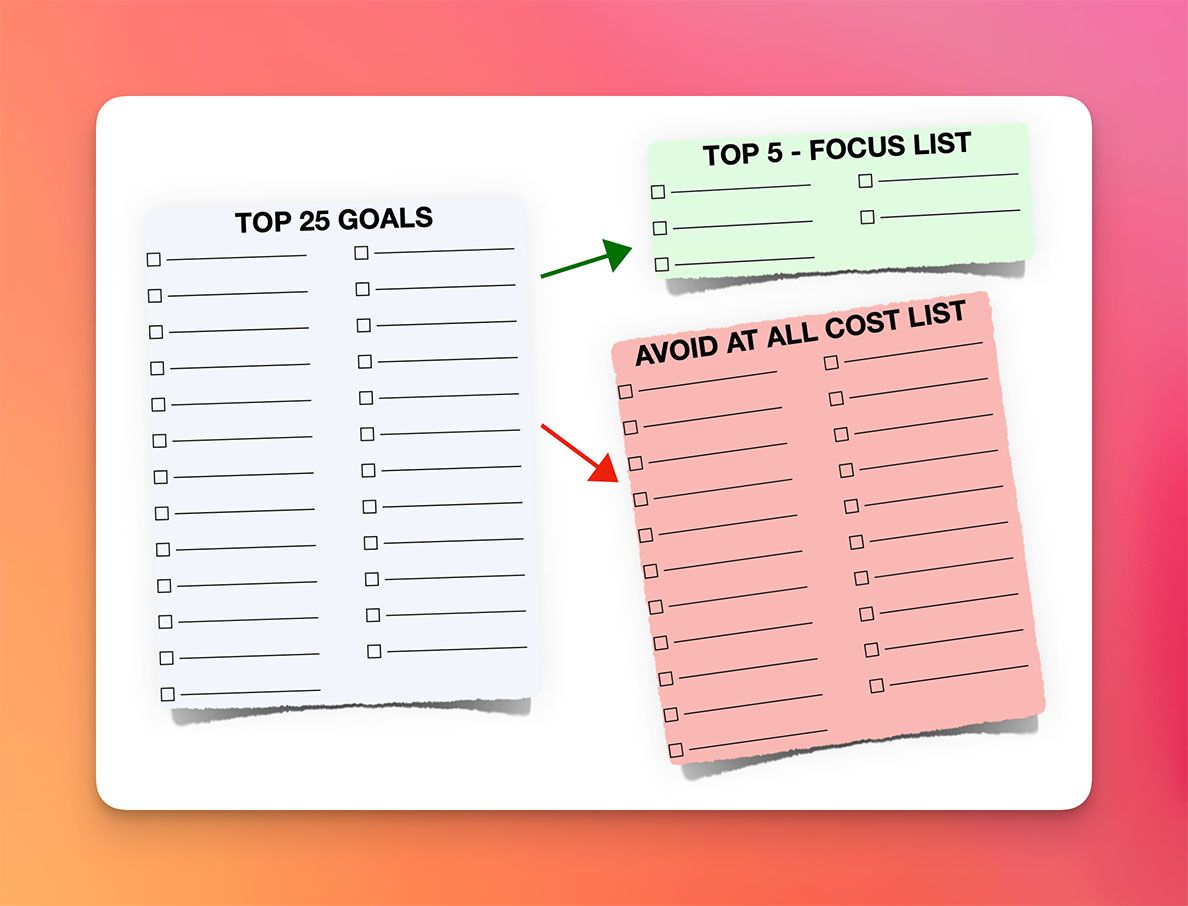Warren Buffet's Two Lists Strategy: How to Get 10x Results
If time is money, then Warren Buffett, a man whose net worth is over $106 billion in 2022, is probably someone we should listen to. His time management strategy is very interesting...

If time is money, then Warren Buffett, a man whose net worth is over $106 billion in 2022, is probably someone we should listen to. His time management strategy is very interesting...
The thing is, he he doesn't use just one to do list. He has two to do lists.
The first one is an ordinary to-do list
We all know this one... This is the list where a person without any time management skill writes down dozens if not hundreds of tasks that would be quite nice to get done one day.
What's the problem? The problem is that they doesn't get them done. And if they actually start working on the tasks from their to do list, the tasks that they finish are usually far from being among the most important ones.
“Be productive, not active.” — Tim Ferris.
At the end of a long day of nonstop work, you collapse onto the couch, completely exhausted and wondering what you managed to accomplish during the day. Does this feeling sound familiar? Well, not to Warren Buffet :)
There is a huge difference between productivity and activity.
Being productive means that are actually completing meaningful things. You are going somewhere. You are getting results. Finishing that PowerPoint presentation is being productive. Obsessing about font color on the first slide is being active.
Have you ever observed a truly successful and productive person? Do they seem overwhelmed with stress? Do they seem "busy"?
In today's corporate culture, it can be easy to get caught up in the idea of busyness. Many companies place value on employees who seem to be constantly occupied and overwhelmed with work, and it can appear that being busy is the key to success. However, this is not always the case. It is possible to be busy all the time and yet not achieve anything meaningful.
Being successful in any endeavor requires knowing three things:
- what needs to be done,
- how to do it
- and when to it all
There is a famous quote pointing out the difference between management and leadership:
Management is doing things right; leadership is doing the right things.” – Peter Drucker
Leadership and management are both essential skills for any successful business. The quote from Peter Drucke highlights the differences between the two and explains why both are necessary for an organization to thrive.
Management is focused on the day-to-day operations of an organization. Managers are responsible for ensuring that tasks are completed correctly and on time. Leadership, on the other hand, is focused on the overall vision of the organization and the strategies necessary to achieve that vision. Leaders need to be able to create a vision, to decide on the right things, and motivate their team to follow it.
Both management and leadership skills are necessary for a successful business. Managers ensure that the tasks necessary to achieve the vision are completed correctly and on time. Leaders set the vision and motivate their team to work towards it.
However, without setting the course, creating a vision, there would be nothing to manage. Therefore, knowing what to do, is way more important, than anything else.
No big news, right?
Yes, we need to prioritise. Of course, I am talking about the necessity to set priorities to our work, to our lives.
Many people utilize the ABC method of prioritizing tasks, which states that tasks should be divided into categories of A (most important), B (medium important), and C (less important). While this method seems helpful for organizing tasks, it's actually broken and it can do more harm than good.
Why even bother doing something that is less important?
It is essential to recognize which tasks are truly important and which are not. It can be tempting to prioritize the tasks that are easier and less time-consuming, but this can be a trap. While these tasks may seem less daunting, they will not help you reach your goals or make meaningful progress.
At times, I have found myself focusing on tasks that are not important and do not benefit me in the long run. It is easy to choose the simpler tasks because they do not require much effort or time.
However, if you devote too much energy to these tasks, you will not have enough energy or time left for the tasks that are truly important.
Let's repeat this: If you devote too much energy to easy tasks, you will not have enough energy or time left for the tasks that are truly important.
Warren Buffett a his 2 Lists Strategy
"The difference between successful people and really successful people is that really successful people say no to almost everything." – Warren Buffet
If I had to say off the top of my head what two questions I get asked most often in my training sessions, it would clearly be these two:
1) How to prioritize;
2) How to say "No".
If you want to be successful, you need to learn to prioritize your tasks and say no to those that are not beneficial. This doesn't necessarily mean making millions of dollars or flying in private jets, but it does mean being able to recognize which tasks are important and which are not.
The story of Mike Plint, Buffet's personal pilot
Mike Flint was Buffett's personal pilot for more than 10 years. At one of their regular meetings, Flint and Buffett talked about careers.
Buffett asked his pilot to write down 25 of his career goals on paper. It took him a while, after all, 25 isn't exactly a small number, but eventually Mike finished and showed his boss.
Second task: Circle your Top 5 goals. Again this took Mike some time, it was hard to decide what was really most important.
Buffett: "So what happened now? What did you circle?"
Flint: "Those are my most important goals, but the other ones are almost as important. If I'm in the mood, I'll definitely work on them at the same time, because some of them are very good."
Buffett: "No, Mike. You're wrong. You know what just happened? You made two lists. The first one is called 'to do list'. The other one is called the 'avoid at all costs' list."

There is always something more and something less important.
If you know the Pareto Principle, you know that 20% of your tasks produce 80% of the results. It might be hard to believe, but it's true.
Just try this. You've probably already tried the phase of doing a hundred things at once in your life. We've all been there. Now is the time of maximum focus.
If you have trouble distinguishing between what is less and more important, try this technique:
- Ask yourself: "What's the worst that can happen if I don't do this thing?" Will you get fired? Will you lose the contract? Will the client call you to send that email again?
- Then the second question: "What's the best thing that can happen if I do this thing?" Will you get a promotion? Do you make a lot of money? Are you going to get praise?
- If you could only do only one single task all day, which one would it be?
Does still everything seem equally important to you? So start with the task you want to do the least. Start with the one that you don't feel like doing. There's probably a good reason for that: It's probably going to be hard and important... :)
Cut out unimportant tasks for maximum productivity
We all know that social media or coffee breaks in the company cafeteria kitchen are distractions. But why don't we look at our B and C priorities the same way? Why? Unimportant tasks are just as distracting as browsing Facebook or watching YouTube videos. Perhaps even more so, because they disguise themselves as workand take up significantly more time. Eliminate them.
